The Indigenous Maleku People
Ethnonyms: Guatuso, Guetar, Malecu, Maléku, Maléku Jaíka, Watuso, Watuso-Wétar Countries inhabited: Costa Rica Language family: Chibchan Language branch: Votic
Click/tap an image to begin a captioned slideshow and, where available, stock licensing information.
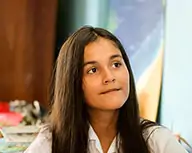
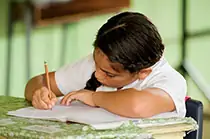 When indigenous children are taught their own language in a formal school setting, it is an unmistakable sign that their language is threatened. This is the case for the Maleku people of Alajuela Province in north-central Costa Rica.
When indigenous children are taught their own language in a formal school setting, it is an unmistakable sign that their language is threatened. This is the case for the Maleku people of Alajuela Province in north-central Costa Rica.
With only a few hundred speakers left, it is probably a case
of when, rather than if, the language becomes extinct. For now, at least, Radio Maleku continues to broadcast in the language from its transmitter in Tonjibe — the largest of three small communities in the Maleku reservation.
I observed two sociolinguistic aspects of language use during my visit: Children spoke to each other almost exclusively in Spanish;
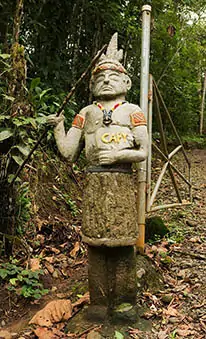 and the better acquainted two adults were,
and the better acquainted two adults were,
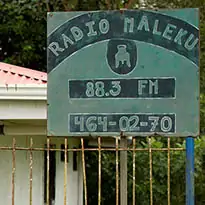 the more likely they were to converse in Maleku versus Spanish.
the more likely they were to converse in Maleku versus Spanish.
Maleku children don't only learn their language in school. They are also taught their cultural history — including their historical religion, folklore and the medicinal properties of local plants. While the latter is one way of preserving the culture, it is done primarily for practical reasons. The Maleku reservation is far away from the nearest well-equipped medical facility. So this education can, quite literally, be a life saver.
The Maleku reservation was formally demarcated by Costa Rica in 1976. It includes a small fraction of the land that the Maleku have historically inhabited. Yet today, about two-thirds of the people who live within that reservation are non-Maleku.
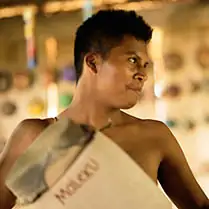 Maleku elders are trying to get their land back — both with money and with political activism. As recently as 2012 they briefly occupied an estate that had been established
illegally on their land.
Maleku elders are trying to get their land back — both with money and with political activism. As recently as 2012 they briefly occupied an estate that had been established
illegally on their land.
The Maleku historically lived off subsistence hunting, fishing and farming. Of these only farming remains and it is still almost entirely subsistence. (Fishing is only allowed by the government on one day per year.)
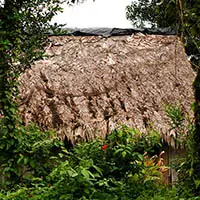 We typically frame the decline of any indigenous people in this part of the world in the context of Spanish colonization.
In fact, though, the Maleku were almost unknown to the Spanish until the mid-Eighteenth Century. Even then they successfully resisted attempts to conquer them.
We typically frame the decline of any indigenous people in this part of the world in the context of Spanish colonization.
In fact, though, the Maleku were almost unknown to the Spanish until the mid-Eighteenth Century. Even then they successfully resisted attempts to conquer them.
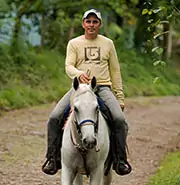 The principal decimation started a hundred years later at the hands of powerful rubber barons from neighboring Nicaragua.
The principal decimation started a hundred years later at the hands of powerful rubber barons from neighboring Nicaragua.
At this same time the Maleku were first contacted by Catholic missionaries. Not only had their numbers declined at the hands of the rubber barons,
many Maleku men had been captured, taken prisoner, enslaved and trafficked for labor. In contrast, the missionaries provided the possibility
of a lifestyle that the remaining Maleku had never known. They introduced them to "modern" items such as metal tools and woven clothing. They also gave them guns to fight off the rubber barons. Following the victory, they encouraged the Maleku to farm crops such as maize and cacao for cash economics.
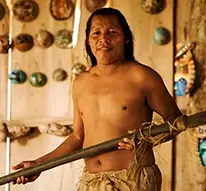 Of course, they also introduced Christianity. Thus began the gradual loss of Maleku culture.
Of course, they also introduced Christianity. Thus began the gradual loss of Maleku culture.
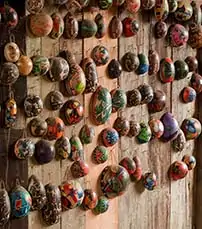 Like most indigenous peoples, the Maleku have their own creation mythology. Toca is the name of their god of creation. Few Maleku worship Him these days — except during re-enactments of ancient ceremonies staged for tourists.
Like most indigenous peoples, the Maleku have their own creation mythology. Toca is the name of their god of creation. Few Maleku worship Him these days — except during re-enactments of ancient ceremonies staged for tourists.
Tourism is a significant part of the Maleku economy these days. While few outsiders visit the reservation for more than a few hours,
many visit the nearby town of La Fortuna, from where it is a convenient bus ride. Many Maleku women have become skilled artisans, making and painting a variety of items for sale to tourists such as balsa wood masks, gourds and musical instruments.
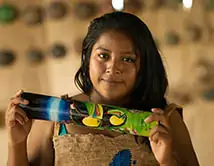 These are now sold at most tourism destinations in Costa Rica as well as internationally.
These are now sold at most tourism destinations in Costa Rica as well as internationally.
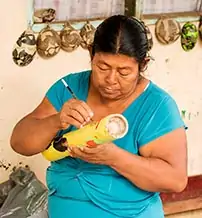
Photography copyright © 1999 -
2026,
Ray Waddington. All rights reserved.
Text copyright © 1999 -
2026,
The Peoples of the World Foundation. All rights reserved.

Waddington, R. (2016), The Indigenous Maleku People. The Peoples of the World Foundation. Retrieved January 16, 2026, from The Peoples of the World Foundation. <https://www.peoplesoftheworld.org/text?people=Maleku>
Web Links
Maleku
Maléku Jaíka (PDF document)
Books
Vásquez, R.C., (2005) An Ethnogeography of the Maleku Indigenous Peoples in Northern Costa Rica. Ann Arbor, MI: University of Michigan Press.

